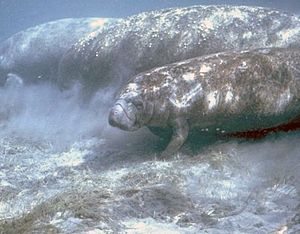List of mammals of the British Virgin Islands facts for kids
Welcome to the exciting world of mammals found in the British Virgin Islands! This article lists all the different kinds of mammals that live there. Sadly, one mammal species in these islands is at risk of disappearing, and another has already gone extinct.
Scientists use special tags to show how much danger an animal species is in. These tags are set by the International Union for Conservation of Nature (IUCN).
| EX | Extinct | This means the animal is completely gone from Earth. |
| EW | Extinct in the wild | These animals only live in zoos or special protected areas, not in the wild. |
| CR | Critically endangered | This animal is in extreme danger of disappearing forever from its natural home. |
| EN | Endangered | This animal is in very high danger of disappearing from its natural home. |
| VU | Vulnerable | This animal is at high risk of disappearing from its natural home. |
| NT | Near threatened | This animal is not in immediate danger, but it might be in the future. |
| LC | Least concern | There are no big worries about this animal right now. |
| DD | Data deficient | We don't have enough information to know how much risk this animal is in. |
Some animals were checked a long time ago. For them, you might see these tags instead of 'Near threatened' or 'Least concern':
| LR/cd | Lower risk/conservation dependent | These animals needed special help to survive, and might be in danger if that help stops. |
| LR/nt | Lower risk/near threatened | These animals are close to being 'Vulnerable' but don't have special protection programs. |
| LR/lc | Lower risk/least concern | There are no worries about these animals right now. |
Contents
Amazing Mammals of the British Virgin Islands
Mammals are a group of animals that have hair or fur, are warm-blooded, and mothers feed their babies milk. Here are some of the fascinating mammals you might find in the British Virgin Islands.
Manatees and Dugongs (Order: Sirenia)

Sirenia is an order of mammals that live completely in water. They are plant-eaters and can be found in rivers, bays, coastal waters, and swamps. All four species of Sirenia in the world are currently endangered.
- Family: Trichechidae (Manatees)
- Genus: Trichechus
- West Indian manatee, T. manatus VU
- Genus: Trichechus
This gentle giant is a large, slow-moving marine mammal. They spend their lives grazing on seagrass and other water plants.
Whales, Dolphins, and Porpoises (Order: Cetacea)
The order Cetacea includes all whales, dolphins, and porpoises. These mammals are perfectly built for life in the water. They have smooth, nearly hairless bodies, a thick layer of blubber for warmth, and their front limbs and tails are shaped to help them swim fast underwater.
Baleen Whales (Suborder: Mysticeti)
These whales have baleen plates in their mouths instead of teeth. They filter tiny sea creatures and plankton from the water.
- Family: Balaenopteridae (Rorquals)
- Genus: Balaenoptera
- Common minke whale, Balaenoptera acutorostrata
- Sei whale, Balaenoptera borealis
- Bryde's whale, Balaenoptera brydei
- Blue whale, Balaenoptera musculus
- Genus: Megaptera
- Humpback whale, Megaptera novaeangliae
- Genus: Balaenoptera
Humpback whales are famous for their long flippers and beautiful songs. They often visit warmer waters to breed.
Toothed Whales (Suborder: Odontoceti)
These whales have teeth and are active hunters, eating fish, squid, and other marine animals.
- Family: Delphinidae (Marine Dolphins)
- Genus: Delphinus
- Short-beaked common dolphin, Delphinus delphis DD
- Genus: Feresa
- Pygmy killer whale, Feresa attenuata DD
- Genus: Globicephala
- Short-finned pilot whale, Globicephala macrorhyncus DD
- Genus: Lagenodelphis
- Fraser's dolphin, Lagenodelphis hosei DD
- Genus: Grampus
- Risso's dolphin, Grampus griseus DD
- Genus: Orcinus
- Killer whale, Orcinus orca DD
- Genus: Delphinus
Killer whales are actually the largest dolphins. They are powerful predators known for their intelligence.
-
- Genus: Peponocephala
- Melon-headed whale, Peponocephala electra DD
- Genus: Pseudorca
- False killer whale, Pseudorca crassidens DD
- Genus: Stenella
- Pantropical spotted dolphin, Stenella attenuata DD
- Clymene dolphin, Stenella clymene DD
- Striped dolphin, Stenella coeruleoalba DD
- Atlantic spotted dolphin, Stenella frontalis DD
- Spinner dolphin, Stenella longirostris DD
- Genus: Steno
- Rough-toothed dolphin, Steno bredanensis DD
- Genus: Tursiops
- Common bottlenose dolphin, Tursiops truncatus
- Genus: Peponocephala
Bottlenose dolphins are well-known for their playful behavior and intelligence.
- Family: Physeteridae (Sperm Whales)
- Genus: Physeter
- Sperm whale, Physeter catodon DD
- Genus: Physeter
Sperm whales are the largest toothed predators on Earth. They can dive very deep to hunt giant squid.
- Family: Kogiidae (Dwarf Sperm Whales)
- Genus: Kogia
- Pygmy sperm whale, Kogia breviceps DD
- Dwarf sperm whale, Kogia sima DD
- Genus: Kogia
- Family: Ziphidae (Beaked Whales)
- Genus: Mesoplodon
- Gervais' beaked whale, Mesoplodon europaeus DD
- Genus: Ziphius
- Cuvier's beaked whale, Ziphius cavirostris DD
- Genus: Mesoplodon
Carnivores (Order: Carnivora)
Carnivores are animals that mostly eat meat. There are over 260 different kinds of carnivores around the world. They have special teeth and skull shapes for eating meat.
- Family: Herpestidae (Mongooses)
- Genus: Urva
- Small Indian mongoose, U. auropunctata introduced
- Genus: Urva
The Small Indian mongoose was brought to the islands by humans.
- Suborder: Pinnipedia (Seals and Walruses)
- Family: Phocidae (Earless Seals)
- Genus: Neomonachus
- Caribbean monk seal, N. tropicalis EX
- Genus: Neomonachus
- Family: Phocidae (Earless Seals)
The Caribbean monk seal is sadly extinct. The last confirmed sighting was in 1952.
See also
- List of chordate orders
- Lists of mammals by region
- List of prehistoric mammals
- Mammal classification
- List of mammals described in the 2000s

